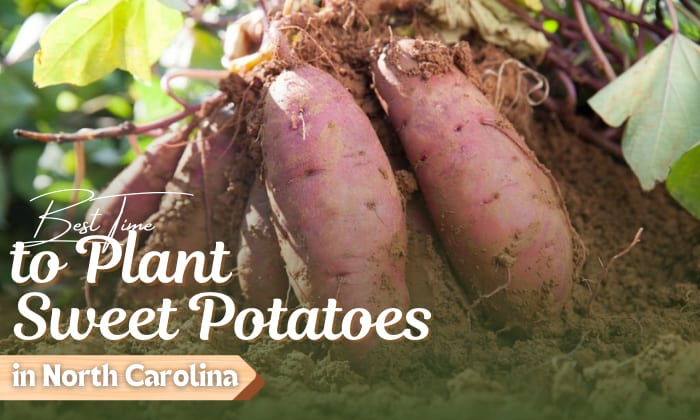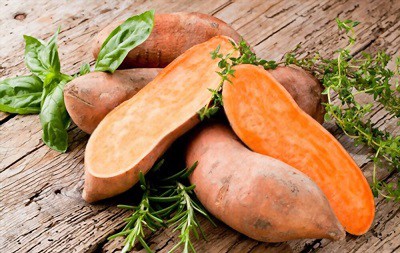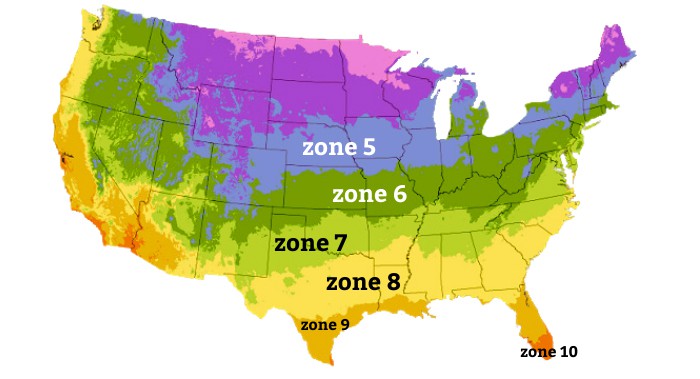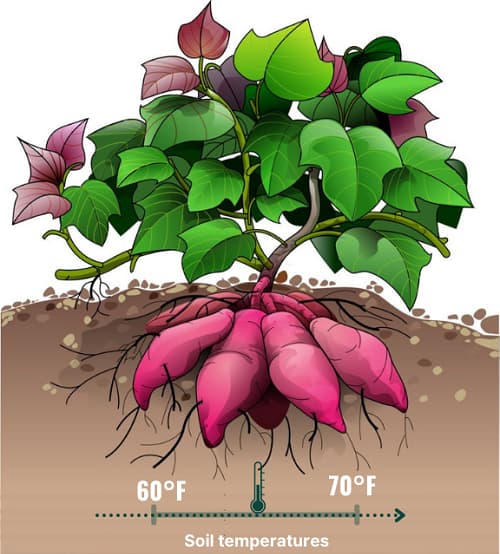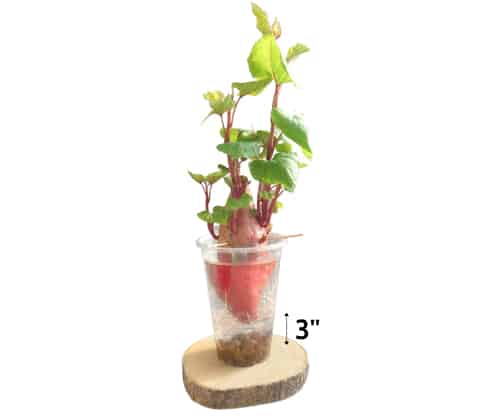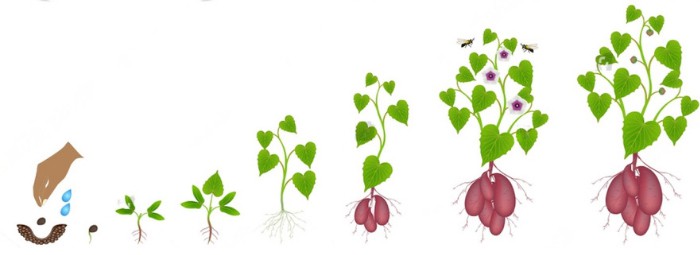Known for being the largest producer of sweet potatoes in the country, North Carolina boasts the ideal conditions for the plants to grow in. If you live in the state, it is important for you to know when to plant them.
So, when to plant sweet potatoes in North Carolina? Generally, the recommended time is from April 16 to May 14, but this depends on the last frost date of your city and planting method.
If you want to successfully grow sweet potatoes in NC, this comprehensive guide will tell you everything you need to know!
Table of Contents
Best Time for Planting Sweet Potatoes in North Carolina
Growing sweet potatoes in NC usually takes place in the spring season, specifically in April and May, when seedlings bedded in March are ready for transplanting or when sprouts are available for planting. The whole process is then completed by June.
Sweet potatoes cannot be planted in later seasons as they are sensitive to frost. Although you can still plant until late June and harvest just before the first fall frost begins, it is a big risk to take as your crops may die or have stunted growth.
Here’s a comprehensive guide to the last frost date per city in North Carolina and when to start planting sweet potatoes:
| City | Last Frost Date | When to Start Planting Outdoors | When to Start Planting Indoors |
| Cary | April 4 | April 25 to May 9 | February 3 to 13 |
| Charlotte / Fayetteville / Greensboro / High Point | April 5 | April 26 to May 10 | February 4 to 14 |
| Concord | April 6 | April 27 to May 11 | February 5 to 15 |
| Durham | April 9 | April 30 to May 14 | February 8 to 18 |
| Raleigh | April 3 | April 24 to May 8 | February 2 to 12 |
| Wilmington | March 26 | April 16 to 30 | January 25 to February 4 |
| Winston-Salem | April 2 | April 23 to May 7 | February 1 to 11 |
Take note that these dates are simply estimates as weather conditions are unpredictable and may change—this means some spring frosts may last longer or shorter than normal.
Where to Plant North Carolina Sweet Potatoes?
When planting outdoors, sprouts or slips that are readily available (i.e., purchased from garden centers, organic stores, etc.) can be directly planted 3 to 4 weeks after the last spring frost date.
On the other hand, you can also produce sprouts yourself by planting sweet potato seeds indoors (e.g. in greenhouses or in containers) 50 days before the last frost date in your area and then transplanting them outside to your garden.
When to Harvest Sweet Potatoes in North Carolina?
Sweet potatoes can be harvested 90 to 120 days after transplanting. Usually, they are dug out of the fields starting in August to early November.
Different Types of Sweet Potatoes
1. Beauregard
Quickest to produce roots that are ready for harvest and consistent in terms of shape, this variety stores well and is resistant to the majority of sweet potato diseases.
It’s ideal for planting this sweet potato when the temperature is at least 60˚F and the soil is 65˚F.
2. Bush Porto Rico
A prolific cultivar that is able to produce heavy yields. It is also characterized by its compact vines, making it an ideal choice for smaller fields.
It’s advisable to grow this type of sweet potato in summer in a growing temperature of at least 65 ˚F for indoor and 65°F to 95°F for outdoor.
3. Covington
Currently the most stocked cultivar in the state, this is a crowd favorite for roasting or mashing. It can handle wet harvest conditions and hold up well in packing and shipping.
Most gardeners recommend the ideal soil temperature for growing covington is at least 70°F.
4. Georgia Jet
A fast-growing variety that is able to produce bountiful yields, this variety has a sugary smell perfect for baking. It thrives well in North Carolina gardens when the soil temperature reaches 65˚ F in the summer.
5. Sumor
Although this variety is not as sweet compared to other types, it can be treated and prepared like a standard white potato. It will take about four months to harvest this type of sweet potato.
How to Plant Sweet Potatoes in NC
1. Location
Sweet potatoes generally grow best in USDA Hardiness Zones 9, 10, and 11. They can still be planted in North Carolina despite the state’s planting zones ranging from Zone 5 to Zone 8, as long as they are planted according to schedule.
Related: Detailed guides and tips to plant sweet potatoes in Florida successfully.
2. Soil Requirements
The plant thrives in well-draining, loamy soils, but they can also do well in fine sandy soils. Those grown in soils that are heavy, clay, or rich in organic content will produce fewer yields with rough and probably misshapen roots.
Ensure that soil temperatures reach between 60°F to 70°F before planting to encourage plant growth.
3. Propagation
The most recommended method is to grow sweet potatoes from a sweet potato itself using slips or sprouts. You can also seed sweet potatoes but it is not the usual method used as it takes up more time.
- Using Slips or Sprouts
To start them indoors, hang a slip with the pointy end of it facing up using toothpicks. Then, place them in a glass of water. Once its roots reach 3 inches in height, transplant it in a pot with well-draining soil or in your garden.
When you’re planting several slips at once, plant them at a distance of 10 to 12 inches wide.
You can also directly plant the slips outdoors by simply inserting them 4 inches deep into compost-amended soil.
- Using Seeds
Sweet potato seeds can be accustomed to produce slips by placing them in soil beds until roots develop and are covered with clear plastic. Once plants start to emerge, you can now transplant them outside.
4. Water
Once established in a field or garden, regularly water up to an inch weekly. Avoid watering during the last 3 to 4 weeks before harvesting.
5. Harvest and Storage
Start harvesting the crops 90 to 120 days after planting or when their leaves start turning yellow. Using a digging fork, loosen about 18 inches of soil around the base of the plant and 4 to 6 inches deep.
Afterwards, pull the primary crown of the plant then carefully lift the sweet potatoes using your hands. Shake the dirt off and avoid washing the roots. Lastly, store the plants in a dry, cool, and well-ventilated container away from heat.
Benefits and Uses of Sweet Potatoes to NC
Aside from health benefits and culinary uses, what makes sweet potatoes important to North Carolina is that it is the largest producer of the crop since 1971, accounting for about 60% of the country’s total production.
In fact, sweet potato is even the designated official vegetable of the state!
They can be a great source of nutrition, including Beta Carotene (or Vitamin A) for healthy bones and immune system, Carbohydrates for energy, Vitamin C, fiber, and more.
Frequently Asked Questions
What is the best sweet potato to grow in North Carolina?
Covington is the most popular variety grown in the state. It has a lightly sugared taste which most people prefer.
Why are so many sweet potatoes grown in NC?
This is because of the state’s warm and humid climate as well as organically rich and fertile soil, which makes ideal conditions for sweet potatoes to grow very well.
Who is the largest sweet potato grower in North Carolina?
Johnny Barnes owns the largest sweet potato farm in North Carolina, the Barnes Farming & Farm Pak, located in Nash County.
Can sweet potatoes grow in hot climates?
Yes. Although they can grow in a variety of climates, they are primarily a warm-season, frost-intolerant crop that thrives best in hot and long growing seasons.
Conclusion
Hopefully as you reach this section of the article you now know when to plant sweet potatoes in North Carolina. Remember: timing is key! Sweet potatoes should be grown after the last spring frost and before the first fall frost of your area.
You should also keep in mind how to grow them so that by harvest time, you have bountiful harvests ready for consuming or for selling in vegetable markets!
Read more: Best time to plant tomatoes in South Carolina

Hi, I am William – Floridayards’ digital content creator. My job is to find answers to all your concerns with thorough research and our team’s expert advice. I will also bring you honest reviews on the best products and equipment for raising your beautiful garden. Please look forward to our work!


